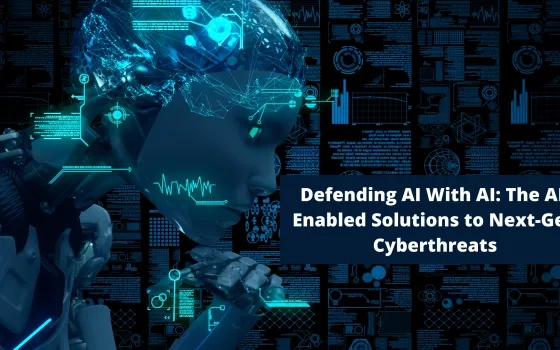The intersection of AI and cybersecurity is a subject of growing concern in the industry, particularly on how AI can be used to mitigate attacks and neutralize threats. Many stakeholders are coming to terms with the fact that AI can be a force of evil too. According to BCG, over 90% of cybersecurity professionals in the US and Japan expect attackers to start using AI to launch attacks. And this is, in fact, becoming a reality already.
AI presents big opportunities for cyber attackers, allowing them to increase attacks in terms of speed, volume, and sophistication to massive proportions. According to Alejandro Correa Bahnsen of Cyxtera, AI-based attacks can bypass traditional detection systems more than 15% of the time — whereas an average phishing attack (without AI) can only detect the attacks 0.3% of the time. An example is #SNAP_R.
Defending AI With AI: The AI-Enabled Solutions to Next-Gen Cyberthreats
In addressing this growing threat, it’s important to note that AI-based offensive requires AI-based defenses. That is, where deepfakes can trick security systems and higher AI-backed authentication should be applied. Et cetera.
Organizations are only just coming to terms with the risks of artificial intelligence. It is pertinent for businesses to act as quickly as possible to protect their systems against these attacks. WannaCry introduced a whole different level of sophistication to cyber-attacks — and now plus AI? That shouldn’t be allowed to happen.
Risks of AI in conducting cyber attacks
1. Scalability
At the 2016 Black Hat Conference, senior researchers debuted an automated spear-phishing program. Spear phishing, ordinarily, is tasking and time-consuming; depending on the scope of the attack. The attacker most likely has to collect large amounts of information about their targets for effective social engineering. Those researchers demonstrated how data science and machine learning can be used to automate and scale spear phishing attacks.
2. Impersonation
Months ago, experts at the Dawes Centre for Future Crime ranked deepfakes as the most serious AI crime threat. It’s not hard to see why. Deepfakes are a tool of disinformation, political manipulation, and deceit. Moreso, malicious actors can use deepfakes to impersonate trusted contacts and compromise business emails (voice phishing) to conduct financial fraud. And the worst is that they are hard to detect.
The possibility of deepfake ridicules voice biometrics and authentication. And these deepfakes will lead people to distrust audio and visual evidence, which have for long been tamper-proof sources of substantiation.
3. Detection-evasion
One way that AI can be used for evading detection is data poisoning. By targeting and compromising the data used to train and configure intelligent threat detection systems, say, making the system label obviously spam emails as safe, attackers can move more stealthily, and more dangerously.
Research shows that poisoning just 3% of a data set can raise error possibility by up to 91%. AI can be used to both evade attacks and adapt to defensive mechanisms.
4. Sophistication
All the points above underscore how AI enhances attacks. AI attacks are worse off because of automation and machine learning. Automation breaks the limit of human effort while machine learning makes the attack algorithms to improve from experience and become more efficient, notwithstanding if attacks are successful or not.
The adaptability means that AI-based attacks will only get stronger and more dangerous unless stronger counter innovations for resistance are developed.
Using AI to defend against AI
A. Machine learning for threat detection
In defending AI with AI, machine learning comes to play to help automate threat detection, especially with new threats that traditional antivirus and firewall systems are not equipped to defend against. Machine learning can significantly reduce instances of false positives, a serious menace in traditional threat detection, by 50% to 90% (cybersecurity intelligencedotcom).
Unlike the detection tools of the previous generation, which are signature-based, machine learning can monitor and log network usage patterns among employees in an organization and alert supervisors when it observes anomalous behavior.
Apparently, 93% of SOCs now use AI and machine learning tools in threat detection. The more data generated and the more sophisticated cyber-attacks get, security professionals will have to enhance their defense and detection capabilities with supervised and unsupervised machine learning.
B. Enhancing authentication via AI
Weak authentication is the most common way by which malicious actors gain unauthorized access to endpoints. And as seen with deepfakes, even biometric authentication no longer seems fail-proof. AI increases the sophistication of defenses by adding context to authentication requirements.
Risk-Based Authentication tools use AI-backed behavioral biometrics to identify suspicious activity and prevent endpoint compromise. Then, authentication extends beyond user verification to real-time intelligence. RBA, which is also called adaptive intelligence, assesses details such as location info, IP address, device info, data sensitivity, etc. to calculate a risk score and grant or restrict access.
For instance, if a person always logs in through a computer at work on workday mornings and on one occasion, tries to log in through a mobile device at a restaurant on a weekend, that may be a sign of compromise and the system will duly flag it.
With a smart RBA security model, merely knowing the password to a system is not enough for an attacker.
In addition to this, AI-powered authentication systems will start implementing continuous authentication, while still using behavioral analytics. Instead of a single login per session, which may be attacked midway, the system works continuously in the background authenticating the user by analyzing user environment and behavior for suspicious patterns.
C. AI in phishing prevention
Enhancing threat detection is one way by which AI can be used to prevent email phishing attacks and also enable safety when using torrenting websites for downloading media contents. It can as well do so with simple behavioral analysis. Say you receive an email purportedly from the CEO, AI can analyze the message to spot patterns that are inconsistent with the manner of communication from the actual CEO.
Features such as writing style, syntax, and word choice can reveal contrarieties, prevent you from falling into the trap and browse and download safely.
AI can also scan email metadata to detect altered signatures, even if the email address looks okay. It also scans links and images to verify their authenticity. Unlike traditional anti-phishing tools which block malicious emails through filters that can be easily bypassed, AI takes up the challenge directly against the core of phishing emails: social engineering.
What makes social engineering attacks difficult to overcome is that they are psychological, rather than technological. Hitherto, sheer human cleverness and skepticism had been tools for overcoming them. Now, AI has upped prevention, extending apprehension beyond human limits.
By recognizing patterns that are not immediately obvious to human beings, AI can determine when an email is malicious even if it does not contain any suspicious links or code. And it does this at scale using automation.
D. Predictive Analytics
The ultimate benefit of AI in cybersecurity is the ability to predict and build up defenses against attacks before they occur. AI can help human overseers to maintain comprehensive visibility over the entire network infrastructure of an organization and analyze endpoints to detect possible vulnerabilities. In this age of remote working and BYOD policies where IT departments increasingly find endpoint security difficult, AI can make their work much easier.
AI is our best bet against zero-day vulnerabilities, allowing us to quickly build smart defenses before those vulnerabilities are exploited by malicious actors. AI cybersecurity is becoming a sort of digital immune system for our organizations similar to how antibodies in the human are becoming system launch offensives against alien substances.
Conclusion
Last year, some Australian Researchers bypassed the famed Cylance AI antivirus without using the common method of dataset poisoning. They simply studied how the antivirus worked and created a universal bypass solution. The exercise called to question the practice of leaving computers to determine what should be trusted and also caused eyebrows to be raised concerning how effective AI is for cybersecurity.
However, more importantly, that research underscores the fact that AI is not a silver bullet and that human oversight remains necessary for combating advanced cyber threats. What we do know is that human effort alone with legacy cybersecurity tools is not enough to overcome the next generation of cyber threats, powered by AI.
We must use AI as the best offense and defense against AI.
Sources/References/Author: Joseph Chukwube




















